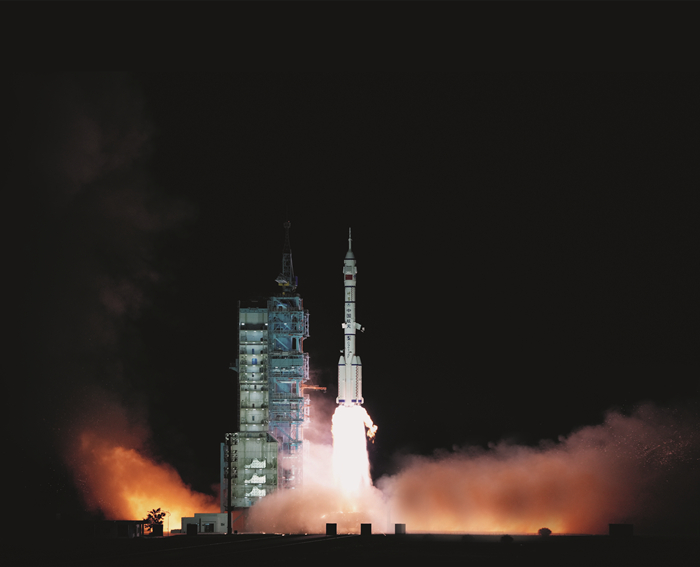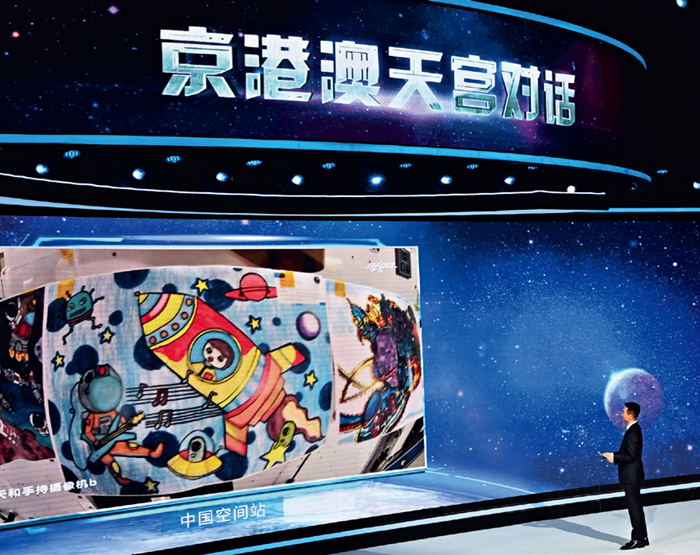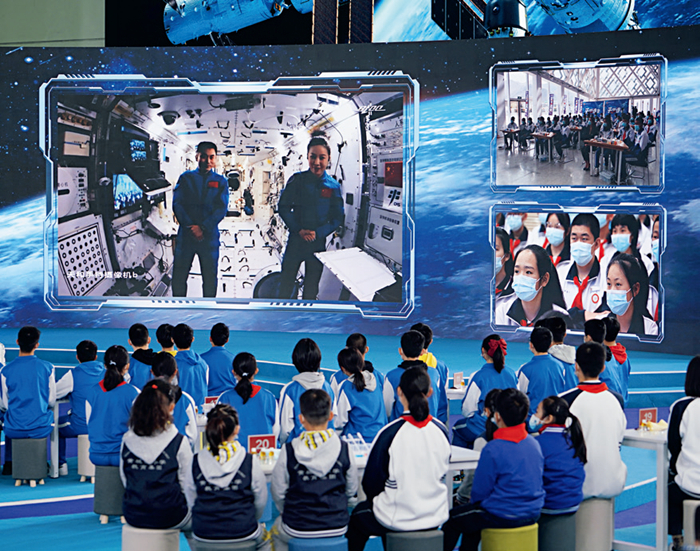|
||||||||||
| Home Nation World Business Opinion Lifestyle ChinAfrica Multimedia Columnists Documents Special Reports |
|
||||||||||
| Home Nation World Business Opinion Lifestyle ChinAfrica Multimedia Columnists Documents Special Reports |
| ChinAfrica |
| Discovering the Space |
| China continues to make breakthroughs in the field of space |
| Edited by Li Kaizhi 丨VOL. 14 MAY 2022 ·2022-05-07 |

The rocket carrying Shenzhou-13 spacecraft blasts off from the Jiuquan Satellite Launch Center, Gansu Province, on October 16, 2021 (XINHUA)
After completing their six-month mission in space, China’s Shenzhou-13 spacecraft crew landed safely at the Dongfeng landing site in north China’s Inner Mongolia Autonomous Region on April 16.
During their six-month stay in the space, the three taikonauts - Zhai Zhigang, Wang Yaping and Ye Guangfu - carried out various tasks related to the construction of the Tiangong space station, conducted scientific and technological experiments, and gave lectures on popular science. They not only comprehensively evaluated the performance of various systems of the space station, but also studied the effects of weightlessness on human health.
As a China-built space station, Tiangong has a mission to contribute to scientific research and human exploration, as well as popularization of space knowledge.
Space lectures
On March 23, from the Tianhe core module of the Chinese space station, the taikonauts held their last space class, which attracted the attention of primary and secondary school students nationwide. In their first class at the end of last year, the three taikonauts showed students the core module and conducted several interesting experiments. The phenomenon of microgravity was the main content of the lecture.
In the class, Wang, assisted by the other two crew members, conducted several scientific experiments, such as the crystallization from a supersaturated solution, a liquid bridge demonstration, water-oil separation and throwing objects in the zero-gravity condition, amazing the students on Earth.
“I have liked to play with water since I was a child, but no matter how I do it, the water bridge is only a few millimeters long, and it will be disconnected when it grows,” Dai Zhihan, a student of the Aerospace City School of the High School Affiliated to the Renmin University of China, said.
Chen Zheng, a member of the space science lecture expert group who participated in the design of the contents of two consecutive space lectures, said that in addition to the space lecture, more manned space-related science education activities are also being planned, so that the seed of love for science can really take root in children’s hearts.

Photo taken in Beijing shows a screen displaying a painting exhibition held in space station Tiangong during a live space-Earth talk between Chinese taikonauts and students in Beijing, Hong Kong and Macao, on January 1 (XINHUA)
Science and research
High cleanliness, high vacuum, microgravity ... These unique advantages provide favorable conditions for scientists to conduct scientific experiments in space. Since the launch of the Shenzhou-1 in 1999, China’s space exploration program has carried out projects with scientific research value and social benefit in successive missions, contributing to scientific research, agricultural development and industrial upgrading.
“The main purpose of building the Tiangong space station is to create a larger space facility to carry out verification and research experiments in orbit on large-scale space science applications to drive scientific progress and technological development,” Zhou Jianping, Academician of the Chinese Academy of Engineering and Chief Designer of China’s Manned Space Program, said.
In the space station, the laboratory cabinets are the main facilities for in-cabin experiments. Each cabinet is a platform for experimental research on a particular field, to meet the needs of different disciplines and different areas of space science experiments.
Taking the high-quality microgravity experiment cabinet as an example, it is mainly used to study the essential laws of motion in microgravity, establish a high-precision time-frequency system in space, and carry out research and application of basic combustion characteristics and mechanism, etc. “With this cabinet, we can conduct more precise experiments to enhance the measurement accuracy,” crew member Ye said.
According to Ye, the trio have carried out diverse studies in fields such as medicine, physics, material science and life science in space. They have also conducted space application experiments related to some advanced detection technologies and traditional Chinese medicine. “We can closely communicate with scientists on the ground, and the experiment data can be transmitted to them in real time,” Ye said.
According to Gao Ming, Commander-in-Chief of the Space Utility System of China’s Manned Space Program, China’s space station involves long-term and systematic planning for research on space life science, microgravity physical science, space astronomy and Earth science, and new space technology and applications, developing a large number of scientific research facilities to support more than 1,000 research projects in orbit.
“After the Wentian and Mengtian laboratory modules are sent into space, the taikonauts will carry out more scientific experiments in broader fields,” Ye said, adding that both Chinese and foreign scientists will then have the opportunity to carry out research aboard China’s space station, which will serve as a space experiment platform for the world.

Photo taken on March 23 shows students, at the China Science and Technology Museum in Beijing, attending a livestreamed popular science lecture given by the taikonauts from the Chinese space station Tiangong (XINHUA)
Looking ahead
On March 4, Zhang Bainan, a deputy to the National People’s Congress and Deputy Chief Designer of China’s Manned Space Program, said that in 2022, China will complete major tasks in six areas in Tiangong space station, launch Wentian and Mengtian laboratory modules and fully complete the space station, to achieve the first combination flight of the station with six spacecraft and two crews of six taikonauts in orbit at the same time.
According to Zhou Jianping, the space station will form a T-shaped configuration and operate in orbit for a long time. The on-orbit service life of the combination is no less than 10 years, and it can be extended through maintenance.
Zhou said that scientists from all over the world will be welcomed to participate in the scientific experiment projects on the Chinese space station. China has already promoted the implementation of the first technical experiment projects with the UN Office for Outer Space Affairs, and has also reached relevant cooperation agreements with several national or regional research institutions in space science and technology.
|
||||||||||||
| About Us | Contact Us | Advertise with Us | Subscribe |
| Copyright Beijing Review All rights reserved 京ICP备08005356号-5 京公网安备110102005860号 |